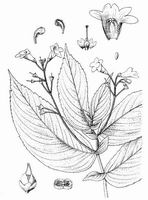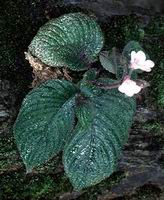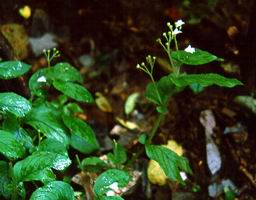
Ying T.S. et al., The endemic genera of seed plants in China, Fig. 129 (1993); with permission.
Full name and orig. publication: Whytockia W.W.Sm., Trans. Bot. Soc. Edinb. 27: 338 (1919).
Etymology: Named in honor of James Whytock (dates unknown), a distinguished Scottish sylviculturist and horticulturist, and president of the Royal Society of Edinburgh.
Synonym: Oshimella Masamune & Suzuki (1934), nom. illeg.
Infrafamilial position: Epithematoid Gesneriaceae.
Description: Perennial monocarpic herbs. Stem base decumbent or creeping, rooting from the nodes, flowering stem ascending or erect; rarely branched or branches from the creeping part (from the axils of fallen leaves). Leaves thin membranous, pubescent, with scattered, sessile chalk glands on the underside, sessile or the large-leaves with a short petiole, ovate, strongly unequal at base, apex acute, margin serrate. Cymes from the axils of the large-leaves, ebracteolate. Sepals connate at base, aestivation descending-imbricate, slightly striate (by presence of secretory canals), chalk glands on inner sides. Corolla white or pink to light violet-purple, tubular-infundibuliform, bilabiate, lobes rounded. Stamens 4, didynamous, inserted at corolla base; filaments hairy in the upper part; anthers coherent, thecae divaricate. Ovary ovoid, glabrous, bilocular throughout or for the most part; stigma slightly capitate or bilobed. Capsule subglobose, 2-valved or opening irregularly.
Chromosome number: 2n = 18.
Species number: 8.
Type species: Whytockia chiritiflora (Oliv.) W.W.Sm.
Distribution: S China (Sichuan, Guangxi, Hunan, Hubei, Guizhou, Yunnan) and Taiwan.
Ecology: On shaded and moist areas in valleys, shaded streamside rocks and streambanks, 500-2200 m.
Notes: The plant architecture, the floral characters (imbricate sepal aestivation, presence of chalk glands, bilocular ovary etc.) and molecular data indicate a close relationship with Monophyllaea and the genus apparently represents a relict from the stock from which Monophyllaea evolved (Weber 1976, 1982, Mayer et al. 2003).
Selected references: Weber, Beitr. Biol. Pfl. 52: 183-205 (1976), morph.; Weber, Notes Roy. Bot. Gard. Edinburgh 40: 359-367 (1982), rev.; Y.Z. Wang, Acta Phytotax. Sin. 33: 1-5 (1995), ibid. 33: 297-301 (1995), new spp.; Y.Z. Wang & Li, Acta Phytotax. Sin. 35: 67-69 (1997), new sp.; Y.Z.Wang et al., Acta Phytotax. Sin. 36: 28-35 (1998), new sp.; Y.Z.Wang, Gu & Hong, Acta Phytotax. Sinc. 36: 28-35 (1998), karyol.; Y.Z.Wang & Pan, Proc. IFCD: 352-366 (1996), fl. morph.; Y.Z.Wang, Acta Phytotax. Sin. 38(3): 231-235 (2000), morph.; W.T. Wang et al., in Wu & Raven (eds.), Fl. China 18: 396-399 (1998) (Chinese spp.); Mayer, Möller, Perret, Weber, Amer. J. Bot. 90 (2): 321-329 (2003), molec. syst.
Bibliography: See Skog, L.E. & J.K. Boggan. 2005. Bibliography of the Gesneriaceae. 2nd edition: http://persoon.si.edu/Gesneriaceae/Bibliography
Illustrations:
 |
Whytockia chiritiflora (Oliv.) W.W.Smith,
type species
Ying T.S. et al., The endemic genera of seed plants in China, Fig. 129 (1993); with permission. |
 |
Whytockia purpurascens
Y.Z.Wang
China, Yunnan, Maguan county, Chuangtianping, phot. M. Möller (no. MMO 01-87). |
 |
Whytockia tsiangiana (Hand.-Mazz.)
A.Weber
S China, Yunnan, phot. Y.Z.Wang (1994). |
last modified: 2007-07-13